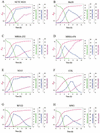Correlation of acetate catabolism and growth yield in Staphylococcus aureus: implications for host-pathogen interactions
- PMID: 12874354
- PMCID: PMC166023
- DOI: 10.1128/IAI.71.8.4724-4732.2003
Correlation of acetate catabolism and growth yield in Staphylococcus aureus: implications for host-pathogen interactions
Abstract
Recently, we reported that the prototypical Staphylococcus aureus strain RN6390 (a derivative of NCTC 8325) had significantly reduced aconitase activity relative to a diverse group of S. aureus isolates, leading to the hypothesis that strain RN6390 has impaired tricarboxylic acid (TCA) cycle-mediated acetate catabolism. Analysis of the culture supernatant from RN6390 confirmed that acetate was incompletely catabolized, suggesting that the ability to catabolize acetate can be lost by S. aureus. To test this hypothesis, we examined the carbon catabolism of the S. aureus strains whose genome sequences are publicly available. All strains catabolized glucose and excreted acetate into the culture medium. However, strains NCTC 8325 and N315 failed to catabolize acetate during the postexponential growth phase, resulting in significantly lower growth yields relative to strains that catabolized acetate. Strains NCTC 8325 and RN6390 contained an 11-bp deletion in rsbU, the gene encoding a positive regulator of the alternative sigma factor sigma(B) encoded by sigB. An isogenic derivative strain of RN6390 containing the wild-type rsbU gene had significantly increased acetate catabolism, demonstrating that sigma(B) is required for acetate catabolism. Taken together, the data suggest that naturally occurring mutations can alter the ability of S. aureus to catabolize acetate, a surprising discovery, as TCA cycle function has been demonstrated to be involved in the virulence, survival, and persistence of several pathogenic organisms. Additionally, these mutations decrease the fitness of S. aureus by reducing the number of progeny placed into subsequent generations, suggesting that in certain situations a decreased growth yield is advantageous.
Figures






Similar articles
-
Staphylococcus aureus aconitase inactivation unexpectedly inhibits post-exponential-phase growth and enhances stationary-phase survival.Infect Immun. 2002 Nov;70(11):6373-82. doi: 10.1128/IAI.70.11.6373-6382.2002. Infect Immun. 2002. PMID: 12379717 Free PMC article.
-
sigma(B) activity in Staphylococcus aureus is controlled by RsbU and an additional factor(s) during bacterial growth.Infect Immun. 2001 Dec;69(12):7858-65. doi: 10.1128/IAI.69.12.7858-7865.2001. Infect Immun. 2001. PMID: 11705968 Free PMC article.
-
Strain-dependent differences in the regulatory roles of sarA and agr in Staphylococcus aureus.Infect Immun. 2002 Feb;70(2):470-80. doi: 10.1128/IAI.70.2.470-480.2002. Infect Immun. 2002. PMID: 11796572 Free PMC article.
-
Regulation of agr-dependent virulence genes in Staphylococcus aureus by RNAIII from coagulase-negative staphylococci.J Bacteriol. 1998 Jun;180(12):3181-6. doi: 10.1128/JB.180.12.3181-3186.1998. J Bacteriol. 1998. PMID: 9620969 Free PMC article.
-
The hemolysins of Staphylococcus aureus.Bacteriol Rev. 1975 Dec;39(4):317-44. doi: 10.1128/br.39.4.317-344.1975. Bacteriol Rev. 1975. PMID: 1108866 Free PMC article. Review. No abstract available.
Cited by
-
Phenotypic Variation Is Almost Entirely Independent of the Host-Pathogen Relationship in Clinical Isolates of S. aureus.PLoS One. 2015 Jun 22;10(6):e0129670. doi: 10.1371/journal.pone.0129670. eCollection 2015. PLoS One. 2015. PMID: 26098551 Free PMC article.
-
Physical-Chemical Properties of Biogenic Selenium Nanostructures Produced by Stenotrophomonas maltophilia SeITE02 and Ochrobactrum sp. MPV1.Front Microbiol. 2018 Dec 19;9:3178. doi: 10.3389/fmicb.2018.03178. eCollection 2018. Front Microbiol. 2018. PMID: 30619230 Free PMC article.
-
Very low ethanol concentrations affect the viability and growth recovery in post-stationary-phase Staphylococcus aureus populations.Appl Environ Microbiol. 2006 Apr;72(4):2627-36. doi: 10.1128/AEM.72.4.2627-2636.2006. Appl Environ Microbiol. 2006. PMID: 16597967 Free PMC article.
-
The Staphylococcus epidermidis Transcriptional Profile During Carriage.Front Microbiol. 2022 Apr 26;13:896311. doi: 10.3389/fmicb.2022.896311. eCollection 2022. Front Microbiol. 2022. PMID: 35558117 Free PMC article.
-
Metabolic footprint analysis uncovers strain specific overflow metabolism and D-isoleucine production of Staphylococcus aureus COL and HG001.PLoS One. 2013 Dec 3;8(12):e81500. doi: 10.1371/journal.pone.0081500. eCollection 2013. PLoS One. 2013. PMID: 24312553 Free PMC article.
References
-
- Baldwin, J. E., and H. Krebs. 1981. The evolution of metabolic cycles. Nature 291:381-382. - PubMed
-
- Bayliss, C. D., and E. R. Moxon. 2002. Hypermutation and bacterial adaptation. ASM News 68:549-555.
-
- Bjorklind, A., and S. Arvidson. 1980. Mutants of Staphylococcus aureus affected in the regulation of exoprotein synthesis. FEMS Microbiol. Lett. 7:203-206.
-
- Blumenthal, H. J. 1972. Glucose catabolism in staphylococci, p. 111-135. In J. O. Cohen (ed.), The staphylococci. Wiley-Interscience, New York, N.Y.
MeSH terms
Substances
LinkOut - more resources
Full Text Sources
Other Literature Sources
Molecular Biology Databases

